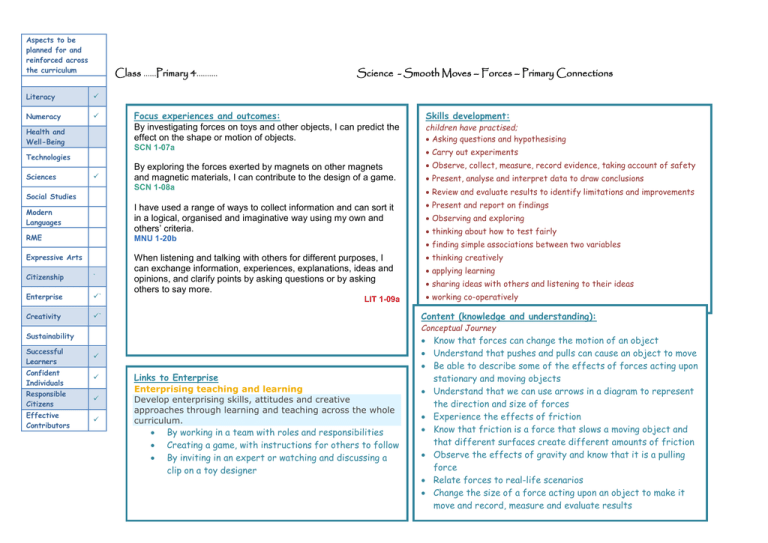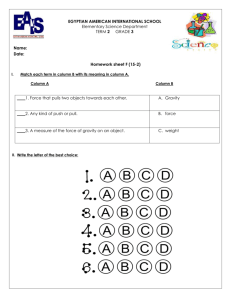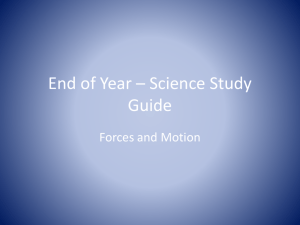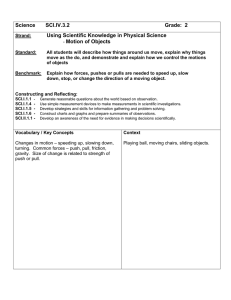Aspects to be planned for and reinforced across the curriculum
advertisement

Aspects to be planned for and reinforced across the curriculum Class ……Primary 4………. Literacy Numeracy Health and Well-Being Science - Smooth Moves – Forces – Primary Connections Focus experiences and outcomes: By investigating forces on toys and other objects, I can predict the effect on the shape or motion of objects. Skills development: SCN 1-07a Carry out experiments Technologies Sciences By exploring the forces exerted by magnets on other magnets and magnetic materials, I can contribute to the design of a game. SCN 1-08a Social Studies RME MNU 1-20b Expressive Arts Citizenship ` Enterprise ` Creativity ` Observe, collect, measure, record evidence, taking account of safety Present, analyse and interpret data to draw conclusions Review and evaluate results to identify limitations and improvements I have used a range of ways to collect information and can sort it in a logical, organised and imaginative way using my own and others’ criteria. Modern Languages children have practised; Asking questions and hypothesising Present and report on findings Observing and exploring thinking about how to test fairly finding simple associations between two variables When listening and talking with others for different purposes, I can exchange information, experiences, explanations, ideas and opinions, and clarify points by asking questions or by asking others to say more. LIT 1-09a thinking creatively applying learning sharing ideas with others and listening to their ideas working co-operatively Content (knowledge and understanding): Conceptual Journey Sustainability Successful Learners Confident Individuals Responsible Citizens Effective Contributors Links to Enterprise Enterprising teaching and learning Develop enterprising skills, attitudes and creative approaches through learning and teaching across the whole curriculum. By working in a team with roles and responsibilities Creating a game, with instructions for others to follow By inviting in an expert or watching and discussing a clip on a toy designer Know that forces can change the motion of an object Understand that pushes and pulls can cause an object to move Be able to describe some of the effects of forces acting upon stationary and moving objects Understand that we can use arrows in a diagram to represent the direction and size of forces Experience the effects of friction Know that friction is a force that slows a moving object and that different surfaces create different amounts of friction Observe the effects of gravity and know that it is a pulling force Relate forces to real-life scenarios Change the size of a force acting upon an object to make it move and record, measure and evaluate results Context : Most of this plan is based on the Primary Connections unit: Smooth Moves. The topic involves the learners finding out about forces in the context of games. Possible Learning and teaching activities (adapt to suit their needs and ideas) and assessment opportunities: What do the children already know?wwhat do they think they will learn about? Elicit initial ideas about forces. Show the children a video clip from Wipe out and talk about what it is that makes the people fall from the obstacles. Discuss pushes and pulls and strength of pushes and pulls. Put a marble in the middle of the circle and ask them to suggest how they could move it. Introduce the topic, telling them that they will be learning about forces through playing, designing and making games. Show them the Smooth Moves word and question wall which they will use during the topic. In co-operative teams the children will play one of the following games: marbles, jenga, mini ten pin bowling, blow football, tiddly winks. Their task is to play the game and then draw an annotated diagram with their ideas about pushes and pulls that are used during the game and how to show the varying strengths of pushes and pulls used. The groups will then feedback their ideas and the learners will get a copy of their teams diagram for their science journals. – Diagnostic assessment (Engage stage) Show the learners a clip of the Apollo rocket taking off. Do they think it would need a big push or a little push to take off? What is giving it the push? Why does it need a big push? Organise co-operative teams in order to make a toy rocket. The children will think about what happens when they change the amount of push their rocket gets. Make straw rockets (or use different materials) and give the children the opportunity to play with them. Let them explore making it go short and long distances. They could also look at how to change its direction. Ask them to discuss different ways to show the different strengths of the pushes they give their rockets when they blow into the straw. Once the rocket is moving through the air, is it still being pushed? Discuss how the rocket gets an initial push and how it then keeps moving but other forces act on it to slow it down. Elicit through discussion that the air is rubbing against it slowing it and there is a force that pulls it to the ground (gravity). Show them a storyboard and explain what it is for. Ask them to complete a storyboard in their science journals, with captions explaining how they varied how far their rocket went with different pushes. Add new words to the word wall and any questions. (Explore) Use some of their questions to create investigations to involve them. Choose at least one question that might involve asking an expert or finding out about the world of work (Teacher TV has some good insights into science/technology and engineering careers) Watch the Spellbound Science episode: A Bad Day and use it to discuss their ideas on friction and what it is. Carry out the activity from Smooth Moves, tug of war where the learners are divided into two teams and have a tug of war but the conditions change e.g. after discussing how the surface of the floor makes it easier or harder, give one group plastic gloves to wear. Put a little fairy liquid on the gloves and let them rub them together and discuss the effects. Introduce the terms friction, force and lubricant. Carry out the activity where they pull a heavy object across different surfaces and discuss how the different surfaces affected the movement and the different sizes of forces needed. Show the learners how to use arrows to represent the direction of forces and their strength and draw different diagrams in the class science journal to represent moving the heavy object over different surfaces. – (Explore) Get the children to investigate the effects of different surfaces on a slope on toy cars. Discuss fair testing with them. Get them to work in cooperative teams to change one variable (the surface, wooden, rough carpet, smooth carpet, plastic) and to measure one variable (distance the toy car travels from the bottom of the slope). Discuss things to watch out for when keeping the test fair. Give them a writing frame for writing up their results and discuss why scientists record and share results. Discuss and evaluate their results with them (Explain) Let them explore science simulation games on BBC science clips and Digger and the gang and record their thoughts on what they found out on a Voki (Explain) Possible Learning and teaching activities (adapt to suit their needs and ideas) and assessment opportunities: Play a game with the children as a class where they try to keep a balloon in the air without letting it fall to the ground. Discuss why it falls. Introduce a globe to the students and ask them if anyone has friends or family that live elsewhere in the world. Ask them to name some countries. Get them to draw a picture of the world and place four people around the world with a ball in their hands, ask them to draw an arrow to show where the person’s ball will go if they drop it. As a class discuss gravity and the different ways that they experience it in their life and describe it as a force that pulls things towards the centre of the Earth. Discuss questions such as: How do we know gravity exists? What effects of gravity can we see or experience? What does the balloon game tell us about gravity? What might happen if there was no gravity? Is there gravity on the moon? At this stage get the children to review their picture and add any thoughts or make any adjustments they feel are necessary. Add the word gravity to the wall (explore) Children could design a game in groups which involves pushes, pulls, friction and gravity. Show them the materials that are available to them, which will include marbles and ask them to draw pictures to show how their game will work. They should also write instructions for their game so that another team would know how to play it. Get the teams to build the games in one session and then play each other’s games in another session, describing the forces that were involved in playing the game. Each team should leave feedback for the team whose game they played saying what they liked about it, suggesting ideas to improve it (Elaborate) Model for the children how to annotate a diagram describing the game of ten pin bowling and the forces at work. Include forces arrows. Now ask the children to draw an annotated diagram in their science journals explaining the game their team designed and the forces involved. Assess their drawings and give formative feedback (Evaluate) The children can fill in a learning journey diary in their journals including questions like: Which activity did you enjoy doing most and why? What new things have you learned? Which activities helped you learn them? What are you still wondering about? If you could do anything what would you like to investigate to find out more about forces? (Evaluate) Use one or two of their wondering questions for activities, investigations, research or home learning. Use the Let’s Think Through Science activities on magnets to investigate non-contact forces. They will explore which materials magnets attract and be introduced to the terms: attract, repel, poles. One of the investigations involves them in sorting a collection of magnets according to how strong they think they might be, to make a hypothesis, then they are asked to devise a test to find out which magnets are strongest. Many of the learners will think strength is related to size and will be surprised by the results They could also design a game that involves magnets SUCCESSFUL LEARNERS WITH: enthusiasm and motivation for learning determination to reach high standards of achievement openness to new thinking and ideas AND ABLE TO: use literacy, communication and numeracy skills use technology for learning think creatively and independently learn independently and as part of a group make reasoned evaluations link and apply different kinds of learning in new situations CONFIDENT INDIVIDUALS WITH: self-respect a sense of physical, mental and emotional well-being secure values and beliefs ambition AND ABLE TO: relate to others and manage themselves be self-aware develop and communicate their own beliefs and view of the world live as independently as they can assess risks and make informed decisions achieve success in different areas of activity RESPONSIBLE CITIZENS EFFECTIVE CONTRIBUTORS WITH: respect for others commitment to participate responsibly in political, economic, social and cultural life WITH: an enterprising attitude resilience self-reliance AND ABLE TO: develop knowledge and understanding of the world and Scotland’s place in it understand different beliefs and cultures make informed choices and decisions evaluate environmental, scientific and technological issues develop informed, ethical views of complex issues AND ABLE TO: communicate in different ways and in different settings work in partnerships and in teams take the initiative and lead apply critical thinking in new contexts create and develop solve problems




